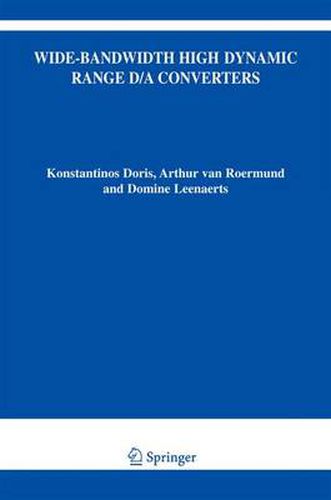Readings Newsletter
Become a Readings Member to make your shopping experience even easier.
Sign in or sign up for free!
You’re not far away from qualifying for FREE standard shipping within Australia
You’ve qualified for FREE standard shipping within Australia
The cart is loading…






This title is printed to order. This book may have been self-published. If so, we cannot guarantee the quality of the content. In the main most books will have gone through the editing process however some may not. We therefore suggest that you be aware of this before ordering this book. If in doubt check either the author or publisher’s details as we are unable to accept any returns unless they are faulty. Please contact us if you have any questions.
IGH-SPEED Digital to Analog (D/A) converters are essential components in digi- Htal communication systems providing the necessary conversion of signals encoding information in bits to signals encoding information in their amplitude vs. time domain characteristics. In general, they are parts of a larger system, the interface, which c- sists of several signal conditioning circuits. Dependent on where the converter is located within the chain of circuits in the interface, signal processing operations are partitioned in those realized with digital techniques, and those with analog. The rapid evolution of CMOS technology has established implicit and explicite trends related to the interface, and in particular to the D/A converter. The implicit relationship comes via the growth of digital systems. First, it is a global trend with respect to all interface circuits that increasing operating frequencies of digital systems place a similar demand for the interface circuits. The second trend takes place locally within the int- face. Initially, the D/A converter was placed at the beginning of the interface chain, and all signal conditioning was implemented in the analog domain after the D/A conversion. The increasing ?exibility and robustness of digital signal processing shifted the D/A converter closer to the end point of the chain where the demands for high quality high frequency operation are very high.
$9.00 standard shipping within Australia
FREE standard shipping within Australia for orders over $100.00
Express & International shipping calculated at checkout
Stock availability can be subject to change without notice. We recommend calling the shop or contacting our online team to check availability of low stock items. Please see our Shopping Online page for more details.
This title is printed to order. This book may have been self-published. If so, we cannot guarantee the quality of the content. In the main most books will have gone through the editing process however some may not. We therefore suggest that you be aware of this before ordering this book. If in doubt check either the author or publisher’s details as we are unable to accept any returns unless they are faulty. Please contact us if you have any questions.
IGH-SPEED Digital to Analog (D/A) converters are essential components in digi- Htal communication systems providing the necessary conversion of signals encoding information in bits to signals encoding information in their amplitude vs. time domain characteristics. In general, they are parts of a larger system, the interface, which c- sists of several signal conditioning circuits. Dependent on where the converter is located within the chain of circuits in the interface, signal processing operations are partitioned in those realized with digital techniques, and those with analog. The rapid evolution of CMOS technology has established implicit and explicite trends related to the interface, and in particular to the D/A converter. The implicit relationship comes via the growth of digital systems. First, it is a global trend with respect to all interface circuits that increasing operating frequencies of digital systems place a similar demand for the interface circuits. The second trend takes place locally within the int- face. Initially, the D/A converter was placed at the beginning of the interface chain, and all signal conditioning was implemented in the analog domain after the D/A conversion. The increasing ?exibility and robustness of digital signal processing shifted the D/A converter closer to the end point of the chain where the demands for high quality high frequency operation are very high.